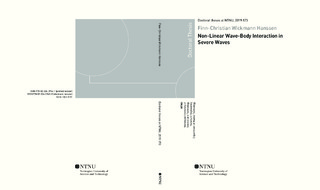| dc.description.abstract | Offshore structures located in harsh environments may experience large wave loads and wave-induced responses. The present thesis documents a twodimensional numerical investigation of interactions between fixed or floating structures and waves. Examined scenarios include large rigid-body motions and steep waves. The main objective of the research has been to develop an accurate and efficient fully non-linear potential-flow method for an incompressible liquid, and to use this in a systematic analysis to provide fundamental insight into wavebody interaction mechanisms beyond the capability of linear and weakly nonlinear methods. Free-surface tension is neglected.
The numerical method uses the harmonic polynomial cell (HPC) method to solve the governing Laplace equation for the velocity potential and its time derivative. The HPC method is a field method where the entire fluid domain is discretized by overlapping cells, and the velocity potential in each cell is represented by harmonic polynomials up to fourth order. Here, the HPC method is proposed combined with novel features that include an immersed boundary method where markers track the time-evolution of the free surface, and using overlapping grids in a domain-decomposition strategy. By doing this, boundaries with arbitrary geometries are managed straightforwardly, and the numerical discretization can be refined locally without increasing the computational cost unnecessarily. Systematic studies are performed to validate the numerical method. It is shown that the solver is able to accurately propagate steep waves in deep and intermediate waters over a long time scale, and to deal with non-linear wave phenomena in shallow water including non-linear dispersion, solitary waves and a steep and eventually breaking focused wave. The method’s ability to deal with local free-surface behavior close to a curved body is confirmed through studying a circular cylinder undergoing forced heave motions in still water.Wave loads on a fixed ship section in beam-sea incident waves show satisfactory agreement with published reference results.
A freely floating ship-section is studied in beam-sea waves with different wave heights. Wave-frequency motions and the mean wave drift force in sway are compared with experimental, numerical and theoretical reference results. Near heave and roll resonance, significant non-linear coupling effects are observed between the different modes of motion. In this wave-frequency range, mean wave drift forces larger than those predicted by second-order theory are observed. For higher wave frequencies, on the other hand, they are lower than from second-order theory.
The latter is confirmed also when the body is restrained from moving. These observations indicate that there are important non-linear effects, beyond the capability of second-order theory, that influence the mean wave drift force. This has relevance for mooring analysis of ship-shaped structures exposed to waves from the side. Contrary to claims made by other authors, the mean wave drift force is estimated most accurately from direct pressure integration. It is found that weakly non-linear methods based on conservation of fluid momentum, such as Maruo’s formula, may be inaccurate and should be used with care in connection with fully non-linear wave-body interaction simulations. The results obtained from conservation of fluid momentum without any additional assumptions are consistent with direct pressure integration, other than when wave-frequency motions are large. It is demonstrated that the mean wave drift force is particularly sensitive to a non-linear term in the body-boundary condition when a separate boundary value problem is solved to estimate the time derivative of the velocity potential. Treating this term erroneously may dramatically increase the mean wave drift force near heave and roll resonance, while wave-frequency motions are insignificantly affected. It is questioned whether this may have contributed to other authors claiming that direct pressure integration is inaccurate in their work.
A domain-decomposition strategy to couple the developed potential-flow method with an existing Navier-Stokes solver based on laminar flow is proposed. Within this framework, viscous effects can be properly accounted for where they matter, while benefiting from the accuracy and efficiency of the potential-flow method elsewhere. The exchange of information between the two solvers is examined for a wave-propagation case. This serves as a guidance towards future work. | nb_NO |
